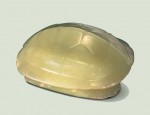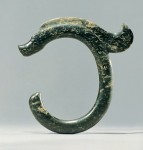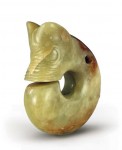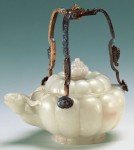Archive for the ‘China’s Cultural Relics’ Category
Jade artifacts of the Hongshan culture
 The Hongshan culture existed about 5,000 years ago, in areas drained by the Liaohe and Xilamulun rivers in northeast China. Jade artifacts of the Hongshan culture are recognized as unique in workmanship and regional character. Most of them take the shape of animals, including turtles, fish hawks, cicadas and dragons, and are just three or four centimeters long with holes drilled through–obviously personal ornaments hanging from the belts of their owners.
The Hongshan culture existed about 5,000 years ago, in areas drained by the Liaohe and Xilamulun rivers in northeast China. Jade artifacts of the Hongshan culture are recognized as unique in workmanship and regional character. Most of them take the shape of animals, including turtles, fish hawks, cicadas and dragons, and are just three or four centimeters long with holes drilled through–obviously personal ornaments hanging from the belts of their owners.
A jade dragon, 26 centimeters long, lays coiled like alphabet C. It is too large  and heavy to be used as a personal ornament. Jade dragons similar in shape but much smaller have been identified as belonging to the Hongshan culture, inferring that the larger jade dragon could be the symbol of something supernatural that held people in awe. To be more specific, the artifact could be hung for worshipping on some special occasions, say at sacrificial ceremonies. If the inference is correct, we may say that jade artifacts were no longer used purely as ornaments in times of the Hongshan culture. Time had begun for use of jade artifacts as ceremonial objects as well.
and heavy to be used as a personal ornament. Jade dragons similar in shape but much smaller have been identified as belonging to the Hongshan culture, inferring that the larger jade dragon could be the symbol of something supernatural that held people in awe. To be more specific, the artifact could be hung for worshipping on some special occasions, say at sacrificial ceremonies. If the inference is correct, we may say that jade artifacts were no longer used purely as ornaments in times of the Hongshan culture. Time had begun for use of jade artifacts as ceremonial objects as well.
“Beautiful stones” and jade
 In making and polishing stone tools, prehistory Chinese found that some stones are exceptionally beautiful with smooth surfaces and lustrous colors. Such stones were broadly referred to as yu, which means “jade”. In Studies of the Principles on Composition of Characters, the very first Chinese dictionary compiled by Xu Shen of the East Han Dynasty (25-220 AD), the character yu is denoted as “beautiful stones”. The so-called “beautiful stones” are not exactly what is termed as “jade” in modern mineralogy. Modern mineralogy classifies jade into “hard jade”, in fact jadeite, which is as hard as glass or even harder, and “soft jade”, which is less hard than glass. To put it in scientific language, hard jade has a 7-degree Vicker’s hardness or greater, while soft jade is leas hard. “Beautiful stones” are none other than “soft jade”, which is good for carving.
In making and polishing stone tools, prehistory Chinese found that some stones are exceptionally beautiful with smooth surfaces and lustrous colors. Such stones were broadly referred to as yu, which means “jade”. In Studies of the Principles on Composition of Characters, the very first Chinese dictionary compiled by Xu Shen of the East Han Dynasty (25-220 AD), the character yu is denoted as “beautiful stones”. The so-called “beautiful stones” are not exactly what is termed as “jade” in modern mineralogy. Modern mineralogy classifies jade into “hard jade”, in fact jadeite, which is as hard as glass or even harder, and “soft jade”, which is less hard than glass. To put it in scientific language, hard jade has a 7-degree Vicker’s hardness or greater, while soft jade is leas hard. “Beautiful stones” are none other than “soft jade”, which is good for carving.
Jade, or “soft jade” to be exact, became the sole “beautiful stone” for making art objects with during the Shang-Zhou period (1,600 BC – 256 BC). The earliest jade artifacts known to us are personal ornaments produced about 7,000 years ago, including hairpins for men, as well as beads and eardrops. These were excavated from the fourth cultural stratum of the Hemudu ruins on the lower reaches of the Yangtze River and the Banpo ruins in Xi’an, Shanxi Province. Immediately after their birth, jade artifacts came to be valued for a unique aesthetic beauty relative to stone, wooden, bone and pottery objects and were taken as symbols for monarchical powers represented by military chieftains and divine powers by wizards. In the most recent three decades, large numbers of jade artifacts have been unearthed from tombs of aristocrats that date back to the Neolithic Era, the Shang-Zhou period and the Qin and Han dynasties. Some of these belong to the Hongshan and Liangzhu cultures.
art objects with during the Shang-Zhou period (1,600 BC – 256 BC). The earliest jade artifacts known to us are personal ornaments produced about 7,000 years ago, including hairpins for men, as well as beads and eardrops. These were excavated from the fourth cultural stratum of the Hemudu ruins on the lower reaches of the Yangtze River and the Banpo ruins in Xi’an, Shanxi Province. Immediately after their birth, jade artifacts came to be valued for a unique aesthetic beauty relative to stone, wooden, bone and pottery objects and were taken as symbols for monarchical powers represented by military chieftains and divine powers by wizards. In the most recent three decades, large numbers of jade artifacts have been unearthed from tombs of aristocrats that date back to the Neolithic Era, the Shang-Zhou period and the Qin and Han dynasties. Some of these belong to the Hongshan and Liangzhu cultures.
Prehistory pottery later than those of the Yangshao culture
It was unearthed at Aohan Banner (county), Inner Mongolia Autonomous Region.”
Archeologists have also found whole arrays of primitive pottery utensils as old as those of the Yangshao culture or produced later. These belong, separately, to the Hongshan culture of northeast China, Dawenkou culture of Shandong Province, Majiayao culture of northwest China and Qijia and Xindian culture that came later, Daxi and the Qujialing cultures of southern China, and the Yunshishan culture prevalent in coastal areas of southeast China.
Even places like Xinjiang and Tibet are home to prehistory ruins from where painted pottery utensils have been excavated. A limited number of painted pottery utensils have been found in some prehistory sites in Taiwan Province, including Dawenkeng at Taibei and Fengbitou at Gaoxiong. These are seen as material evidence to contacts between prehistory Chinese on either side of the Taiwan Strait.
Painted patterns on Yangshao portery 3
Discovery of the Banpo Neolithic Village in 1954 is regarded as an important supplement to studies of the Yangshao culture. Ruins of the primitive village that existed over a period from 4,800 BC to 4,500 BC are in perfect conditions. Decorative patterns on pottery utensils unearthed from there take the shape of human faces, fish and deer and other animals, and archeologists link them to witchcraft characteristic of primitive religions.
One example is a pottery kettle with the ends bent upward and fishing net-like patterns painted on its body – obviously modeled after a primitive dugout canoe which, archeologists say, expresses hope of its producer for a good catch and should have something to do with primitive witchcraft. Mysteries surrounding some human face-like patterns remain to be cracked. Most “faces”, so to speak, are round and have straight noses and long, narrow eyes with triangular dunce caps on, as well as fish dangling from both corners of the mouth or on the forehead. Archeologists attribute such patterns to wizards chanting incantations for a good catch of fish.
Patterns of astronomical phenomena should be attributed to primitive agriculture and to understanding of astronomy by prehistory people. Some patterns are realistic in style, with the sun and moon, for example, painted as they actually look like. But in most cases techniques of symbolism were used, with the bird symbolizing the sun and the frog, the moon. Research has led to the conclusion that primitive Chinese thought the bird was the soul of the sun and the frog, the soul of the moon.
Bird and frog images are found on painted pottery produced not later than 7,000 years ago. Those on some of the earliest works are quite realistic in style but, as time went by, such images became increasingly geometrical and mysterious. Use of bird and frog images as theme patterns had continued for well over 3,000 years until the bird image changed into a golden crow and the frog image, into a toad with three legs. In classical Chinese poetry and essays, the sun is often referred to as the “golden crow” and the moon, as the “magic toad”.
Bird and fish images in decorative patterns on prehistory pottery can also be seen as totems. Different clans or tribes had different ancestral roots, hence their different totems. Struggles or alliances between different clans or tribes found an artistic expression in patterns picturing fights or unions between different animals. A pottery vase unearthed in Linru County, Henan Province, is a typical case in point. The vase is painted with a picture 37 centimeters tall and 44 centimeters wide, depicting a fierce-looking white stork with a fish, stiff and motionless, in its long beak. A large stone ax is seen at the right side of the bird, with the handle wrapped in pieces of a textile or with a rope wound round it, on which signs that look like alphabet X are painted. The ax might be symbol of the powers enjoyed by the chieftain of a tribe. The bird is done without an outline, its color, pure white, posing a sharp contrast to the fish and ax done with black outlines. It seems that prehistory artists already knew how to increase the artistic effect of their works by using such techniques as contrast.